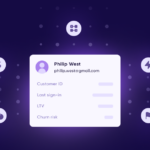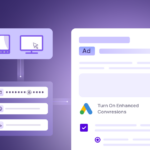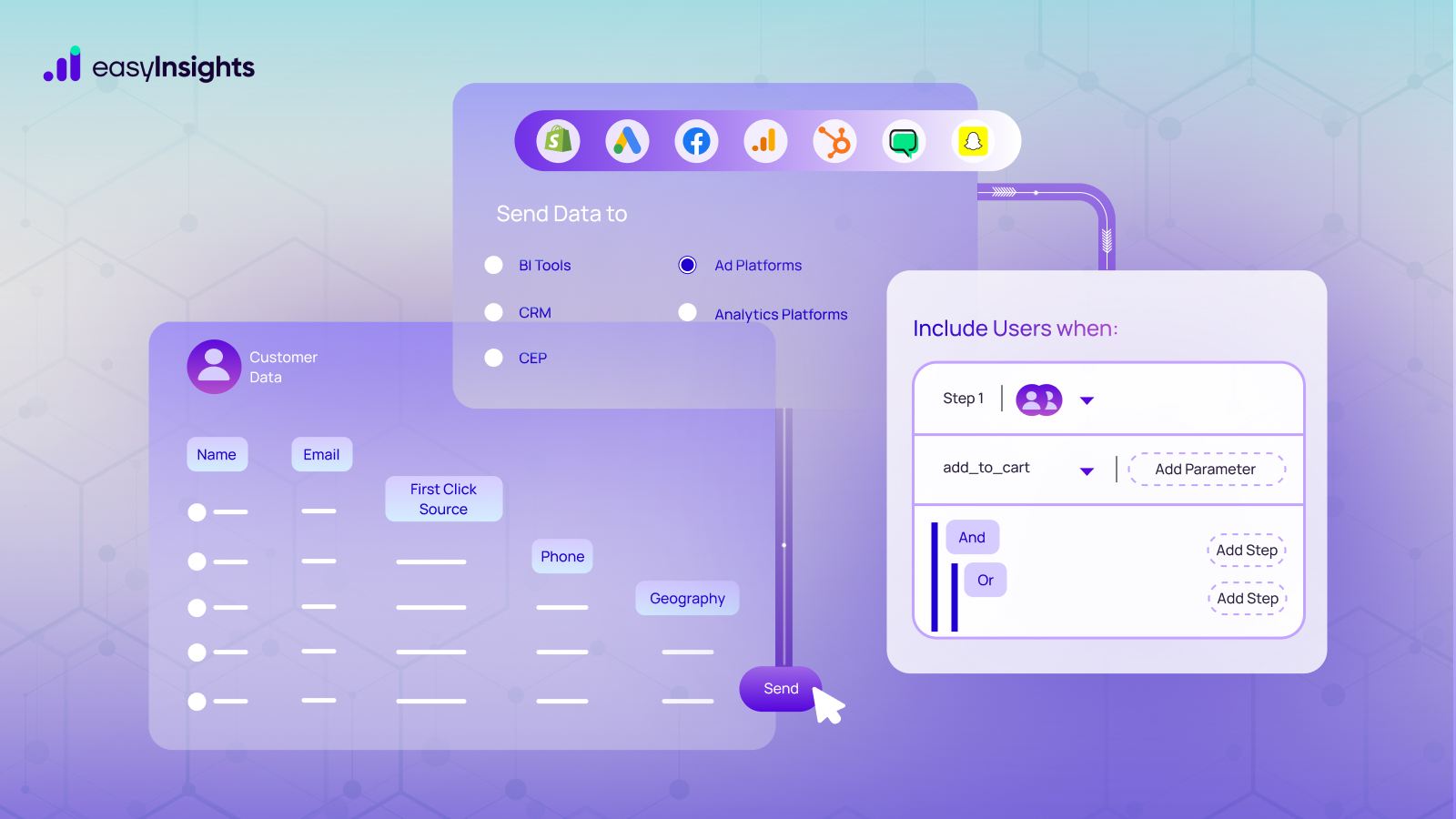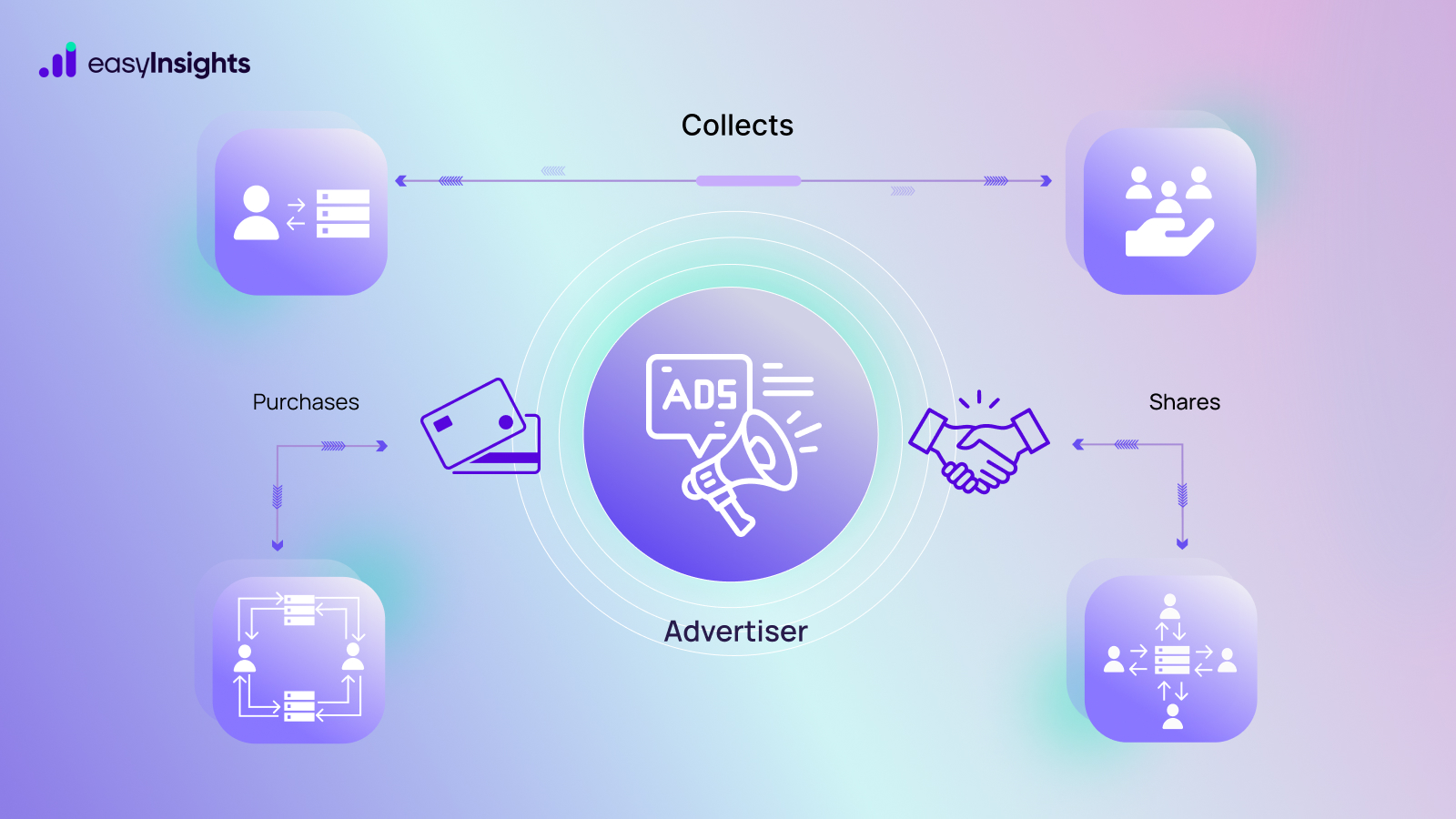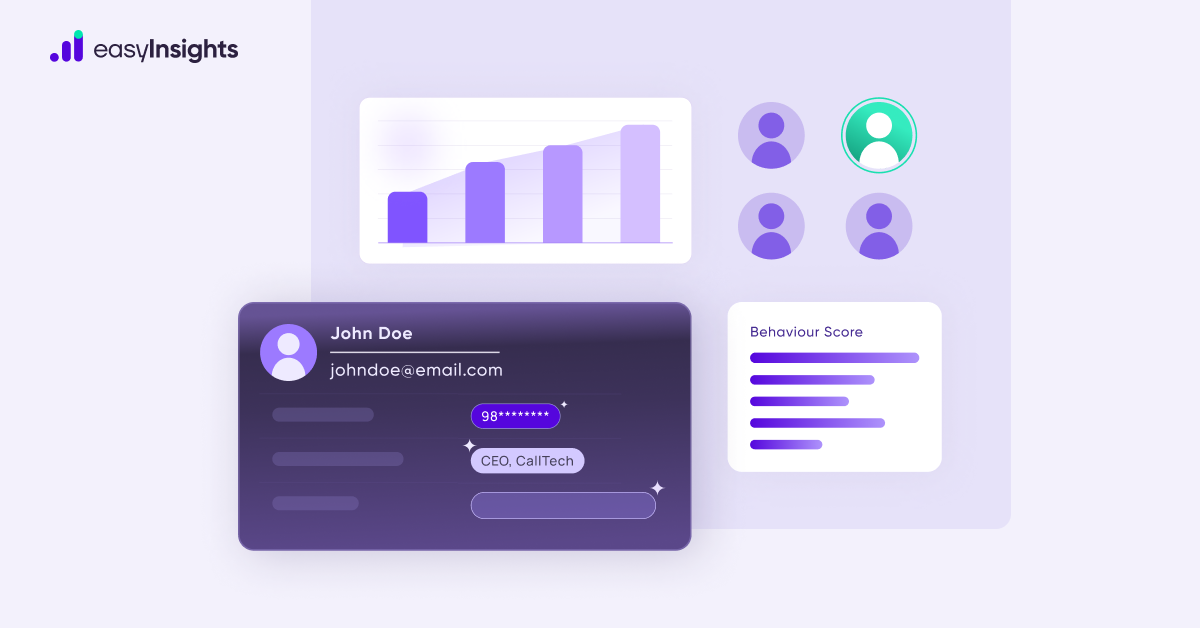
“$5.7 billion” – This is the estimated size the CDP (Customer Data Platforms) market is expected to reach in 2026. However, a major chunk of this growth wouldn’t come from the CDPs as you know them today. Instead, brands will adopt what is called a Composable CDP.
A composable CDP takes a more modular approach to activating customer data. It one-ups traditional CDPs in many aspects of data management, be it collecting both first-party and third-party data, support for custom schema, or the ability to connect with any business app.
Join us in this detailed comparison of traditional CDPs vs composable CDPs. This blog post will walk you through key differences between the two CDPs and help you pick the right solution for your team.
Jump ahead to:
What Are Traditional CDPs?
A traditional CDP, or packaged or bundled CDP, is a ready-to-deploy solution for collecting, storing, modeling, and activating customer data. The primary purpose of these platforms is to help marketers use available data to create consistent and unified customer profiles for personalizing user experience and creating targeted ad campaigns.
These CDPs use proprietary SDKs to collect behavioral and event data, which they unify into a comprehensive customer 360 using built-in identity resolution mechanisms. These profiles are then synced to your various business applications.
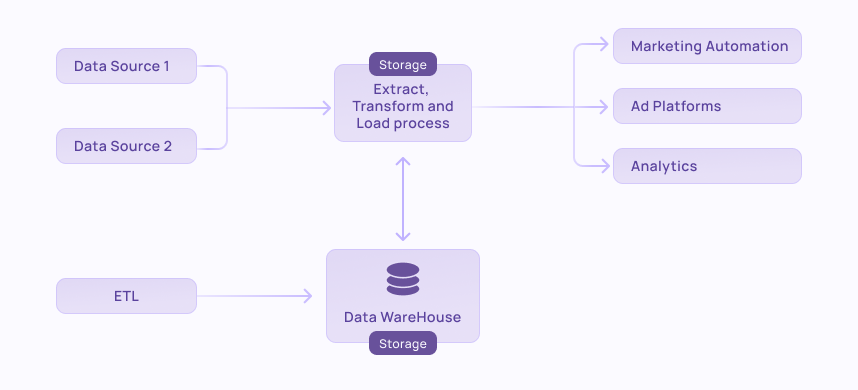
What Are Composable CDPs?
A composable CDP also helps marketers collect data from various touchpoints and activate unified profiles to martech tools downstream. However, unlike traditional CDPs, a composable CDP stores all customer data within your data warehouse, not the vendor’s. They feature modular architecture that allows you to build a CDP around your existing data infrastructure instead of investing in a separate standalone data platform. As a result, you can use custom data types and create your own models and integrations tailored to your needs.
Composable CDPs perform all the functions their packaged counterparts do but more efficiently. Here’s how they work:
- ETL: Composable CDP sits on top of your data warehouse, so it leverages the ETL (extract, transform, load) method to collect all kinds of customer data, including web and mobile events, SaaS tools, offline events, and even 2nd and 3rd party data.
- Identity Resolution and Enrichment: The platform then matches identifiers like email addresses and device IDs to create a comprehensive view of each customer. With access to a data warehouse, composable CDPs can enrich these profiles with additional data like demographic information, preferences, and behaviors.
- Data Activation: Data activation is at the core of composable CDPs, providing orchestration tools to automate data onboarding, a point-and-click interface to build audiences, and reverse ETL tools to sync data downstream.

Additional Read: Composable CPDs: Some Common Misconceptions
Difference Between Traditional and Composable CDP
Here are some key differences between a regular CDP and a Composable CDP:
1. Role of Data Warehouse
Both traditional and composable CDPs have a data warehouse in the center of their infrastructure. However, a key difference is in the ownership of the data warehouse.
For a traditional CDP, the vendor owns and manages the data warehouse. As a result, your CDP can only work with event data collected from the web and mobile. It can’t leverage your existing first-party data and models to build customer profiles.
However, Composable CDPs work on top of your existing infrastructure, allowing them to store customer data directly in your warehouse. As a result, you can use events and behavioral data from various first- and third-party sources to build comprehensive customer profiles.
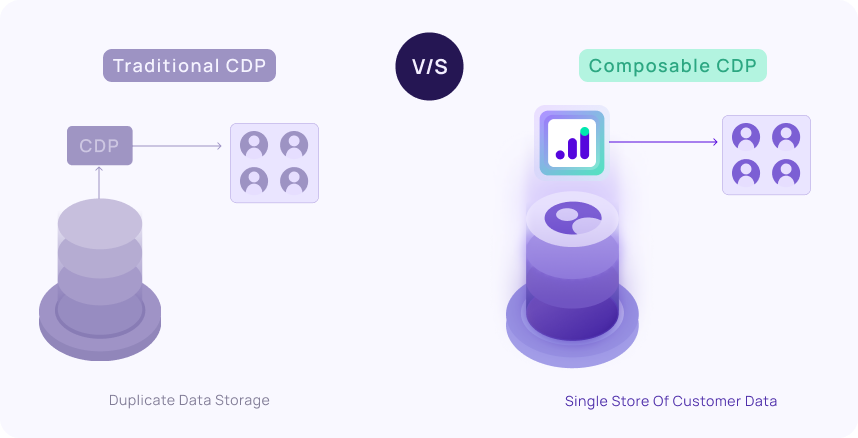
2. Ease of Deployment
While traditional CDPs are advertised with tags like “out-of-the-box” and “ready-to-use,” it can take more than six months to implement one, from signing the contract to building pipelines and training your team.
In order to be “ready-to-use,” packaged CDPs offer preconfigured tools with rigid structures. As a result, you can’t integrate solutions as flexibly as you’d like. You are basically locked in the vendor’s platform, and migrating to a different solution in the future becomes a challenge. Composable CDPs integrate with your existing tech stack, be it data warehouse, ETL pipelines, or event collection systems, integrate with your existing tech stack. This allows for faster deployment, and there’s no risk of getting locked into one vendor’s ecosystem.
3. Flexibility of Data Models
Traditional CDPs have a one-size-fits-all approach to activating customer data. When you deploy such a solution, you can only use user and account-based data models. You can’t use first-party data or customize the predefined data models. Moreover, vendor lock-in makes it challenging to migrate your data and models in the future.
Composable CDPs, on the other hand, are schema-agnostic platforms. So, you have the flexibility to work with diverse data formats and models without conforming to vendor’s predefined and rigid schemas.
4. Availability of Visual Audience Builder
Thanks to their rigid data models, audience building in traditional setup is mostly based on predefined rules set by the vendor. So, you don’t get no-code tools to build segments and audiences. Any customizations to audiences from your side would require the direct involvement of data teams.
Composable CDPs do not have preconfigured data models. These solutions prioritize data activation, so they often come bundled with visual builders specifically for non-tech users. You can easily build audiences and experiment with data modeling using point-and-click interfaces.
5. Downstream Data Sync Method
Depending on your CDP type, data is stored in your or the vendor’s warehouse. As a result, the method used to sync data downstream is also slightly different.
Traditional CDPs use the approach called data orchestration, i.e., customer data and audiences stored in the vendor’s warehouse are synced to connected marketing tools. You can’t sync data models stored in your warehouse using this method.
Conversely, composable CDPs rely on the reverse ETL approach. As you may already know, the ETL method allows you to transport any data into your warehouse. Similarly, reverse ETL lets you export every data type from the warehouse to the application downstream.
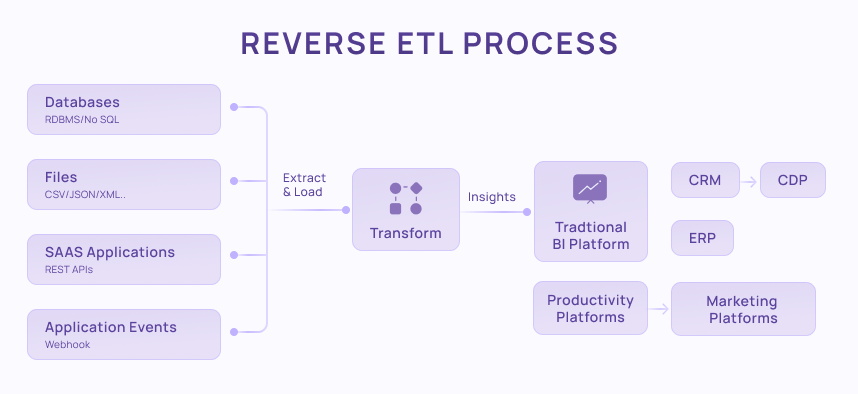
6. Cost of Investment
For businesses that already have an established data infrastructure, buying a traditional CDP can be an expensive investment with poor returns. That’s because you’ll have to pay for an entire catalog of bundled tools even if you don’t use them all.
Composable CDPs have established themselves as a cost-effective solution with their modular approach to customer data activation. Unlike traditional CDPs, where you pay for the complete package, you only pay for the features and integration you use.
7. Privacy Compliance
Ensuring privacy compliance when using a traditional CDP can be a challenge. Since much of your data is stored outside your infrastructure, you have to rely on vendors to implement critical data governance checks and processes.
However, a composable CDP keeps your data within your warehouse. As a result, you control data governance and privacy compliance from head to toe, be it access control, encryption, data anonymization and minimization policy, consent management, etc.
Additional Read: Choosing the Right Data Activation Platform for Your Business
Traditional CDP vs Composable CDP: A Head-to-Head Comparison
| Feature | Composable CDP | Traditional CDP |
| Flexibility | These let you integrate various components and tools based on your specific needs. | They are less flexible because they come with predefined components. |
| Modularity | Their modular architecture allows you to assemble components like building blocks. | Their integrated architecture has tightly coupled and predefined components. |
| Scalability | They are easily scalable as you can adapt and expand by adding or updating components as needed. | The predefined structure and capacity of these platforms limit their scalability. |
| Integration | Seamless integration with a wide range of tools and systems, allowing for a best-of-breed approach. | Integration capabilities are confined to the scope of the platform, which may limit compatibility with external tools. |
| Customization | You can tailor a composable CDP to your unique processes and data needs. | A traditional CDP’s structure and capabilities are largely set by the vendor. |
| Implementation Time | Composable CDPs offer quicker implementation by seamlessly integrating with existing systems, thanks to their modular design. | Traditional CDPs have longer setup times due to their fixed structures needing more adaptation to fit into existing tech ecosystems. |
| Vendor Dependency | Reduced dependency on a single vendor; businesses can swap out components as needed. | Higher dependency on the vendor for updates, support, and integration with new technologies. |
Final Words
Composable CDPs are designed to accomplish what traditional CDPs set out to do a decade ago. And they are much better at it. They give you complete control of your customer data, allowing you to model it as per your needs. Moreover, you can even leverage your existing data to create more accurate customer profiles to power your personalization efforts.
There’s no doubt that composable CDPs are best, especially for marketers with proper data infrastructure. So, if you need a composable CDP for your company, EasyInsights is the answer.
EasyInsights is a marketing analytics and automation platform that helps you build a robust CDP around your data infrastructure. It provides real-time blended data integrations, giving you a 360-degree view of users’ online and offline activity. Moreover, its no-code approach lets marketers build data models and integrations without data teams.
Schedule a demo today to see EasyInsights in action!
Additional Read: The Relevance of Composable CDPs – Marketer’s POV


